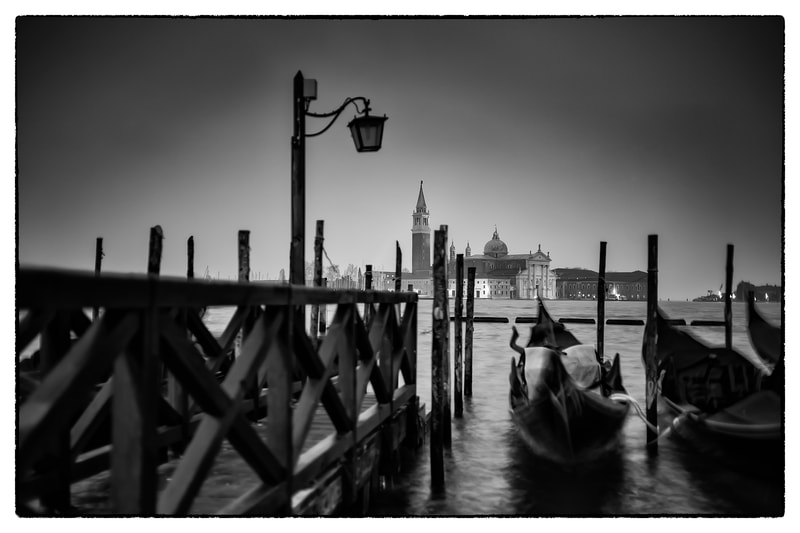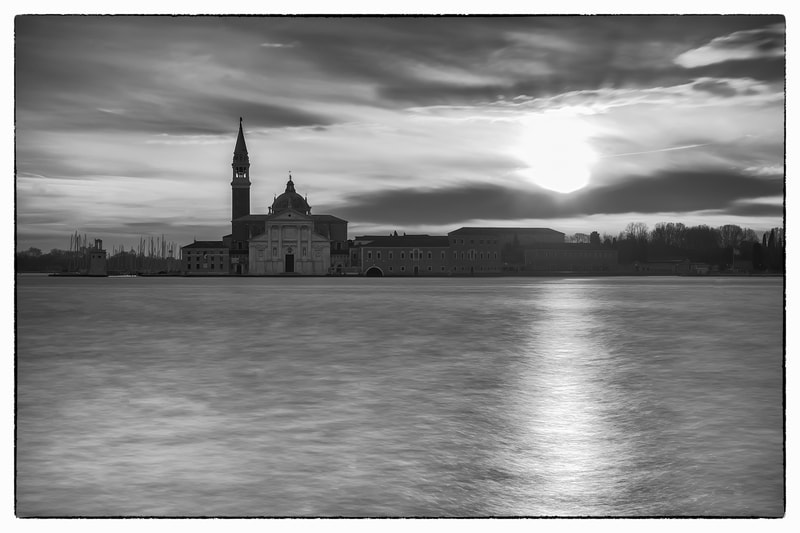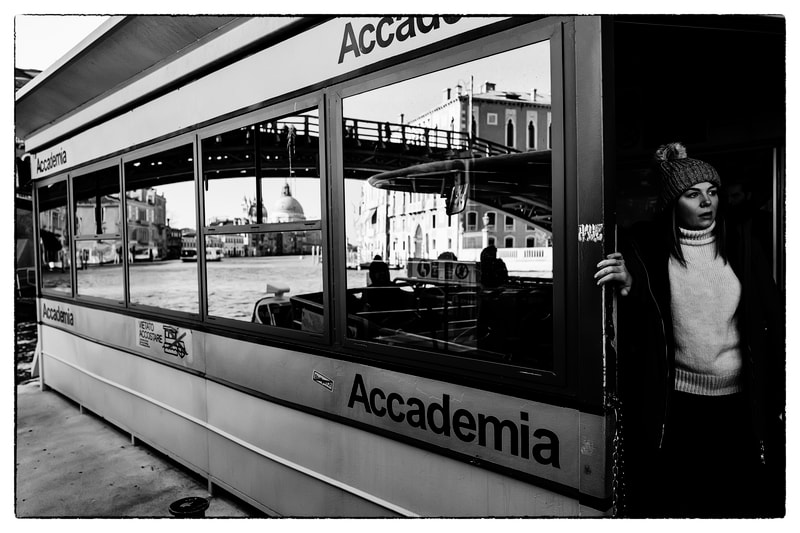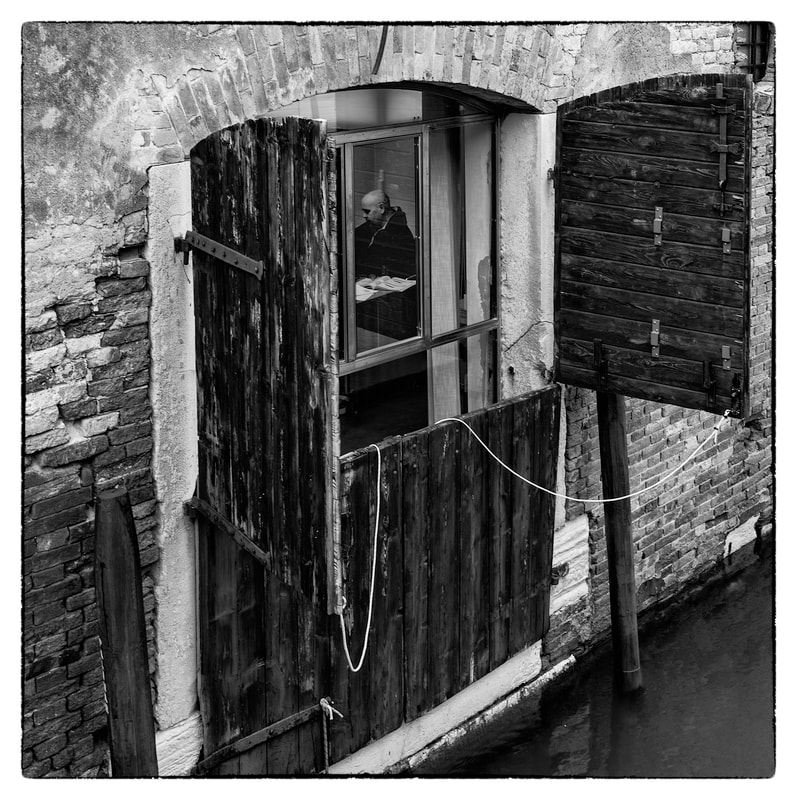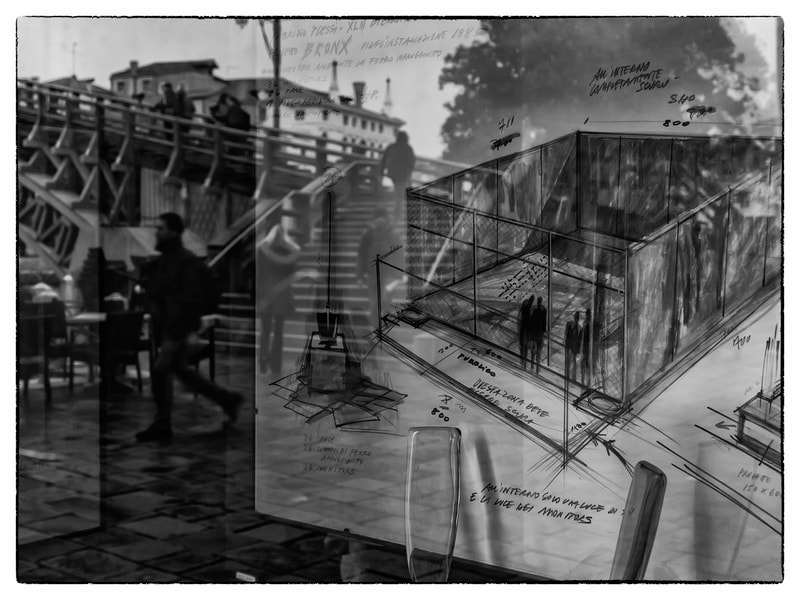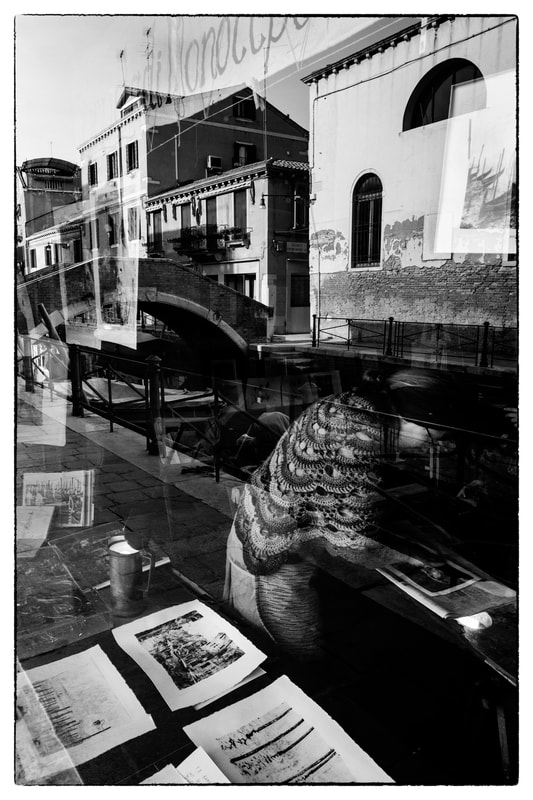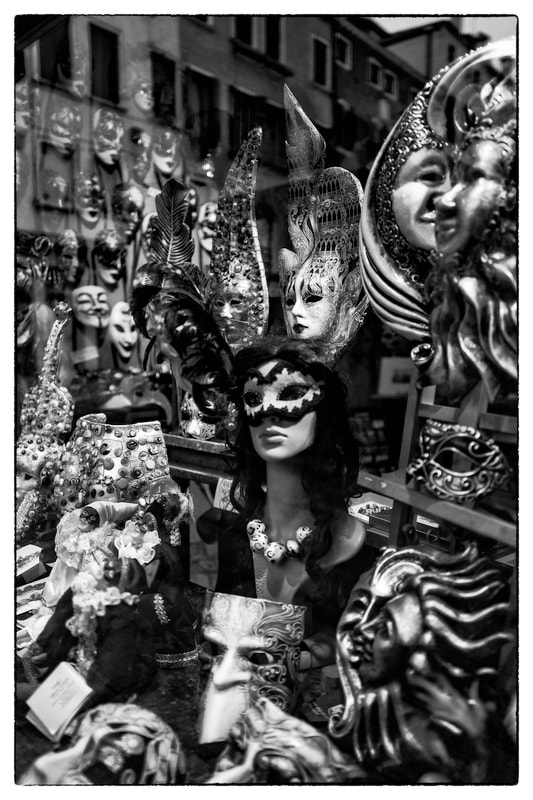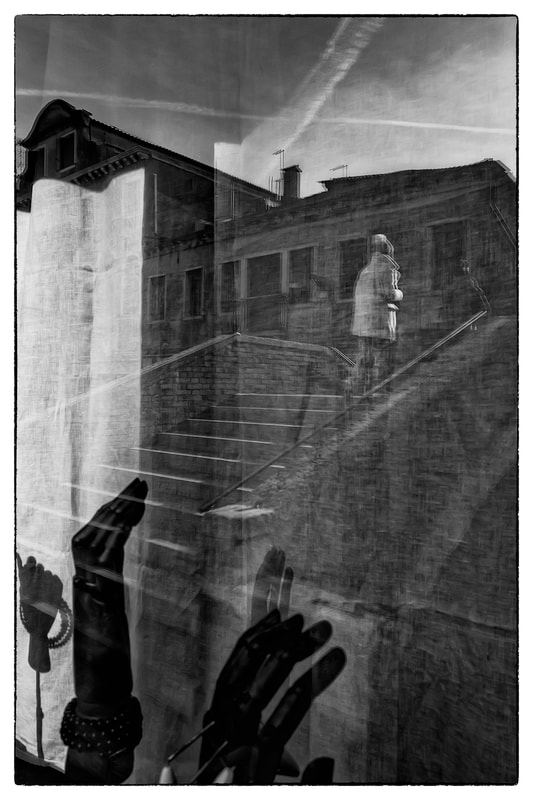Venice B&W Photography Workshop
The following images are the result of participating in a black and white photography workshop during January of 2019. With Venice as a backdrop, organized and led by UK photographer Steve Gosling: https://www.stevegoslingphotography.co.uk, this workshop focused experienced photographers (4 of us) on two key challenges:
I would add a third challenge - implicitly adopted by all of the workshop participants before we even got there: “Don’t do the usual Instagram travel-photography thing.” There were sub-challenges and learning experiences - I won’t bore you with details.
With unexpectedly clear and sunny weather (and cold, as expected), we all had to quickly drop an anticipated core theme: moody, atmospheric, “mysterious” images of Venice cloaked in its winter fog and mist. None of those weather “props” were supplied, and we all had to pivot to different, individually-determined, themes.
In the end, after trying a few approaches that just didn’t work or inspire me, I settled on the overarching theme of “Reflections”. Sub-themes, under that umbrella, emerged over the days. What this meant, practically, was that I concentrated on images that involved using reflections in windows or, in some cases, in the water to capture what interested me visually, expressed a story and/or a feeling.
The sub-themes that emerged included: “What’s inside, what’s outside?”, “What’s real or solid, what’s reflected?”, and (you’ll have to wait to see those images below): “The inner life of inanimate objects”. With the first two, I wanted to create questions in the viewer’s mind, to present a bit of a puzzle, to create doubt (if only temporary) about what belongs where. Some of these images can be confusing to the viewer - at least at first - but that was part of the intent: to challenge the viewer to sort out "what belongs where?" or "what does it mean?".
The last sub-theme, the most difficult to achieve more than once, presented itself while reviewing an image one evening in which puppets or “mannequins” inside the window of an antiques shop seemed (at least to me) to be longing to jump up and enter the “real” world, to join the passers-by reflected from the outside onto that same window. Intrigued, I then looked for, and found (or they found me?), other opportunities to convey that sense of inanimate objects seeming to watch, interact with or join the “real world”.
What also pleased me (as a bit of a photography purist) about these somewhat abstract images is that they are exactly as I framed and shot them - straight out of the camera. There was no ”Photoshopping” (in the negative popular sense of “overworking” and “distorting” the original image) - no compositing, no cropping (except in the few square formats included), no radical “surgery”. I did only two things:
All this can be done (granted with some skill and effort) developing and printing black and white film in a conventional “wet” darkroom. I’m not arguing the case of film vs digital, old school vs new school here - I’ll leave that to others. Digital capture and printing are the only practical options for me. What I am emphasizing is that though some of these images might appear at first glance - or even after lengthy review - to be heavily “Photoshopped” or “composited” creations - they are decidedly not. They are images straight out of the camera, converted to black and white and then subjected to an absolute minimum of post-processing in Photoshop geared only to better render my photographic intent.
Aside from fleshing out our core theme, we all had long-term projects or things we wanted to learn. For me, at this workshop, those were: candid street shots of people (locals going about their lives), and learning the core techniques of long time exposures using neutral density filters and a tripod. The latter, almost by definition, became the most obvious "standard" images of Venice but, I hope, with a “twist” or a mood you haven’t seen on every postcard or Instagram snap of the city.
Still, in many, though not all, of the resulting images, I aimed to incorporate a sense of place (Venice) - sometimes obvious, sometimes less so - without making it all about Venice. The exceptions are the time exposures, which can only be described as “straight-on-Venice”.
The images are organized into three sections:
I really enjoyed this time of year in Venice - the relatively low (and often avoidable) visitor count and a more relaxed, local and accessible feel than during the high tourist season.
For those that are interested, here is a list of gear used:
Without further ado . . .
Hint: Click on images you want to enlarge. Hover on the image and left/right arrows will take you forward or backward within each of the three sections.
The following images are the result of participating in a black and white photography workshop during January of 2019. With Venice as a backdrop, organized and led by UK photographer Steve Gosling: https://www.stevegoslingphotography.co.uk, this workshop focused experienced photographers (4 of us) on two key challenges:
- Make creative black & white images in (and if you wanted “of”) this iconic city.
- Develop and stick to a focused theme, ideally outside your “comfort zone”, and present a mini-portfolio of six images to the group at the end of the workshop. This proved very challenging but also proved to be an invaluable (and lasting) learning experience.
I would add a third challenge - implicitly adopted by all of the workshop participants before we even got there: “Don’t do the usual Instagram travel-photography thing.” There were sub-challenges and learning experiences - I won’t bore you with details.
With unexpectedly clear and sunny weather (and cold, as expected), we all had to quickly drop an anticipated core theme: moody, atmospheric, “mysterious” images of Venice cloaked in its winter fog and mist. None of those weather “props” were supplied, and we all had to pivot to different, individually-determined, themes.
In the end, after trying a few approaches that just didn’t work or inspire me, I settled on the overarching theme of “Reflections”. Sub-themes, under that umbrella, emerged over the days. What this meant, practically, was that I concentrated on images that involved using reflections in windows or, in some cases, in the water to capture what interested me visually, expressed a story and/or a feeling.
The sub-themes that emerged included: “What’s inside, what’s outside?”, “What’s real or solid, what’s reflected?”, and (you’ll have to wait to see those images below): “The inner life of inanimate objects”. With the first two, I wanted to create questions in the viewer’s mind, to present a bit of a puzzle, to create doubt (if only temporary) about what belongs where. Some of these images can be confusing to the viewer - at least at first - but that was part of the intent: to challenge the viewer to sort out "what belongs where?" or "what does it mean?".
The last sub-theme, the most difficult to achieve more than once, presented itself while reviewing an image one evening in which puppets or “mannequins” inside the window of an antiques shop seemed (at least to me) to be longing to jump up and enter the “real” world, to join the passers-by reflected from the outside onto that same window. Intrigued, I then looked for, and found (or they found me?), other opportunities to convey that sense of inanimate objects seeming to watch, interact with or join the “real world”.
What also pleased me (as a bit of a photography purist) about these somewhat abstract images is that they are exactly as I framed and shot them - straight out of the camera. There was no ”Photoshopping” (in the negative popular sense of “overworking” and “distorting” the original image) - no compositing, no cropping (except in the few square formats included), no radical “surgery”. I did only two things:
- Converted RAW files to black and white.
- Adjusted contrast or brightness and “dodged and burned” some areas to better define the image.
All this can be done (granted with some skill and effort) developing and printing black and white film in a conventional “wet” darkroom. I’m not arguing the case of film vs digital, old school vs new school here - I’ll leave that to others. Digital capture and printing are the only practical options for me. What I am emphasizing is that though some of these images might appear at first glance - or even after lengthy review - to be heavily “Photoshopped” or “composited” creations - they are decidedly not. They are images straight out of the camera, converted to black and white and then subjected to an absolute minimum of post-processing in Photoshop geared only to better render my photographic intent.
Aside from fleshing out our core theme, we all had long-term projects or things we wanted to learn. For me, at this workshop, those were: candid street shots of people (locals going about their lives), and learning the core techniques of long time exposures using neutral density filters and a tripod. The latter, almost by definition, became the most obvious "standard" images of Venice but, I hope, with a “twist” or a mood you haven’t seen on every postcard or Instagram snap of the city.
Still, in many, though not all, of the resulting images, I aimed to incorporate a sense of place (Venice) - sometimes obvious, sometimes less so - without making it all about Venice. The exceptions are the time exposures, which can only be described as “straight-on-Venice”.
The images are organized into three sections:
- Time Exposures
- People
- Reflections (my core theme of choice).
I really enjoyed this time of year in Venice - the relatively low (and often avoidable) visitor count and a more relaxed, local and accessible feel than during the high tourist season.
For those that are interested, here is a list of gear used:
- Cameras: Leica M10 w. APO Summicron ASPH 50mm or Summilux 35mm lens; Leica Q Summilux w. 28mm fixed lens; Olympus OMD EM1-Mkii w. 14-100mm Pro zoom lens - my foul-weather back-up (only placed in service on one rainy morning: I prefer prime lenses).
- For time Exposures: Gitzo Traveler carbon fiber tripod w. RRS head; Lee ND and Graduated ND filters (to 10 stops).
Without further ado . . .
Hint: Click on images you want to enlarge. Hover on the image and left/right arrows will take you forward or backward within each of the three sections.
TIME EXPOSURES
PEOPLE
REFLECTIONS



